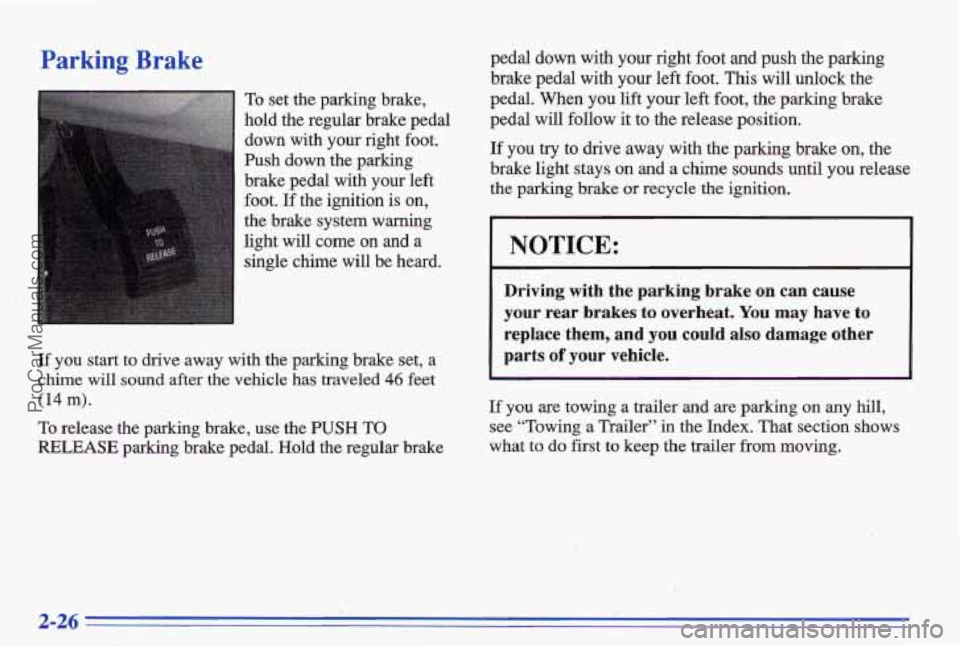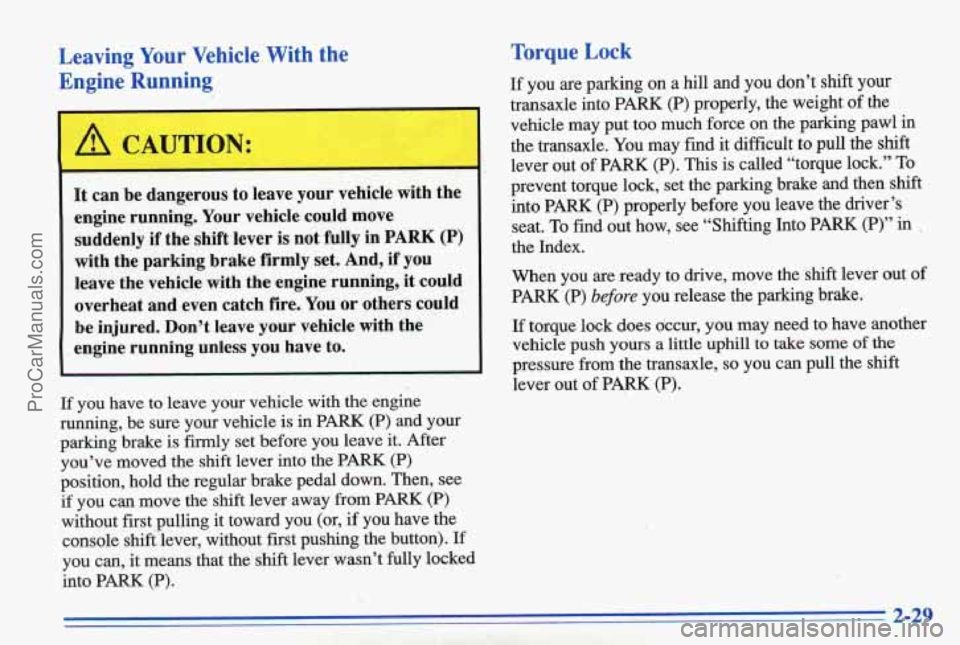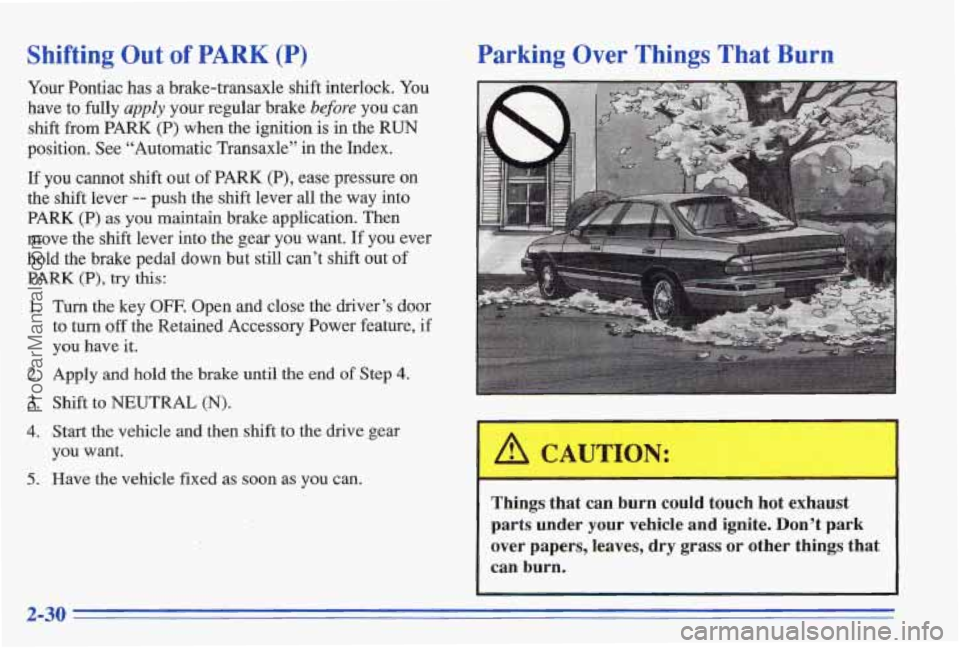Page 6 of 387
Vehicle Symbols
These are some of the symbols you may find on your vehicle.
For example, these symbols are used on
an
original battery:
POSSIBLE A
CAUTION
INJURY
PROTECT EYES BY
SHIELDING
CAUSTIC
BURNS AVOID
SPARKS
OR
FLAMES
SPARK
OR ,\I/,
COULD
RAM€
EXPLODE BATTERY
These symbols are
important
for you and
your passengers whenever your
vehicle
is
driven:
f-l DOOR LOCK
UNLOCK
FASTEN SEAT
BELTS
e?
AIR BAG p
These symbols
have to do with your lights:
SIGNALS e
TURN
PARKING
p$ LAMPS
FOG LAMPS
$0
These symbols are on some of
your controls:
WIPER Q
WINDSHIELD
DEFROSTER
VENTILATING
FAN - )
These symbols are used on
warning
and
indicator lights:
ENGINE
COOLANT
- e-
TEMP -
CHARGING I-1
BATTERY
SYSTEM
BRAKE
(0)
COOLANT a
ENGINE OIL e,
PRESSURE
ANTI~LOCK (@)
BRAKES
Here are some
other symbols
you
may see:
FUSE
LIGHTER
m
HORN )tr
SPEAKER
b
FUEL p3
v
ProCarManuals.com
Page 72 of 387
Automatic Transaxle Operation
Your automatic transaxle may have a shift lever
located on the console between the seats or on the
steering column.
There are several different positions for your shift lever.
PARK (P): This locks your front wheels. It’s the best
position to use when you start your engine because your
vehicle
can’t move easily. It
is dangerous to get out of your vehicle if the
shift lever
is not fully in PARK (P). with the
parking brake firmly set. Your vehicle can roll.
Don’t leave your vehicle when the engine
is
running unless you have to. If you have left the
engine running, the vehicle can move suddenly.
You or others could be injured.
To be sure your
vehicle won’t move, even when you’re
on fairly
level ground, always set your parking brake and
move the
shift lever to PARK (P).
See “Shifting Into PARK (P)” in the Index. If
you’re pulling
a trailer, see “Towing a Trailer” in
the Index.
2-21
ProCarManuals.com
Page 77 of 387

Parking Brake
To set the parking brake,
hold the regular brake pedal down- with
your right foot.
Push down the
parking
brake pedal with your left .
foot. If the ignition is on,
the brake system warning
light will come on
and a
single
chime will be heard.
If you start to drive away with the parking brake set, a
chime will sound after the vehicle has traveled 46 feet
(14
m).
To release the parking brake, use the PUSH TO
RELEASE parking brake pedal. Hold the regular brake pedal down with
your right foot and push the parking
brake pedal with your left foot. This will unlock the
pedal. When you lift your left foot, the parking brake
pedal will
follow it to the release position.
If you try to drive away with the parlung brake on, the
brake light stays
on and a chime sounds until you release
the parking brake or recycle^ the ignition.
I
NOTICE:
Driving with the parking brake on can cause
your rear brakes to overheat.
You may have to
replace them, and you could also damage other
parts
of your vehicle.
If you are towing a trailer and are parking on any hill,
see “Towing a Trailer” in the Index. That section shows
what
to do first to keep the trailer from moving.
2-26
ProCarManuals.com
Page 78 of 387
Shifting Into PARK (P)
I
It can be dangerous to get out of your vehicle if
the shift lever is not fully
in PARK (P) with the
parking brake firmly set. Your vehicle can roll.
If you have left the engine running, the vehicle
can move suddenly.
You or others could be
injured.
To be sure your vehicle won’t move, even
when you’re on fairly level ground, use the steps
that follow.
If you’re pulling a trailer, see
“Towing
a Trailer” in the Index.
Steering Column Shift Lever
1. Hold the brake pedal down with your right foot and
set the parking brake.
2. Move the shift lever into PARK (P) position like this:
Pdl the lever toward you.
ProCarManuals.com
Page 79 of 387
I
0 Move the lever up as far as it will go.
3. Move the ignition key to LOCK.
4. Remove the key and take it with you. If you can
leave'your vehicle with the ignition key in your
hand, your vehicle
is in PARK (P).
Console Shift Lever
1. Hold the brake pedal down with your right foot and
2. Move the shift lever into PARK (P) position like this:
set the
parking brake.
Hold in the button on the lever.
Push the lever all the way toward the front of
the vehicle.
3. Move the ignition key to LOCK.
4. Remove the key and take it with you. If you can leave
you vehicle with the ignition key in your hand, your
vehicle is in PARK (P).
2-28 . .
ProCarManuals.com
Page 80 of 387

Leaving Your Vehicle With the Engine Running
c- 1
It can be dangerous to leave your vehicle with the
engine running. Your vehicle could move
suddenly if the shift lever
is not fully in PARK (P)
with the parking brake firmly set. And, if you
leave the vehicle
with the engine running, it could
overheat and even catch fire. You or others could
be injured. Don’t leave your vehicle with the
engine running unless
you have to.
I I
If you have to leave your vehicle with the engine
running, be sure your vehicle
is in PARK (P) and your
parking brake
is firmly set before you leave it. After
you’ve moved the shift lever into the PARK
(P)
Torque Lock
If you are parking on a hill and you don’t shift your
transaxle into BARK (P) properly, the weight of the
vehicle may put too much force on the parking pawl
in
the transaxle. You may find it difficult to pull the shift
lever out of PARK (P). This is called “torque lock.” To
prevent torque lock, set the parking brake and then
shift
into PARK (P) properly before you leave the driver’s
seat.
To find out how, see “Shifting Into PARK (P)” in I
the Index.
When you are ready to drive, move the shift lever out
of
PARK (P) before you release’ the parking brake.
If torque lock does dccur, you may need to have another
vehicle push
yours a little uphill to take some of the
pressure from the transaxle, so you can pull the shift
lever out of
PARK (P).
position, hold the regular brake pedal down. Then, see
if you can move the shift lever away from PARK (P)
without first pulling it toward you (or, if you have the
console
shift lever, without first pushing the button). If
you can, it means that the shift lever wasn’t fully locked
into PARK (P).
;. -i . . . . . .. . , , , , , .?..?e,: ,a ”g; .- -_- , ,.i._.. , .. . .-. -. .-:e ?, ’ . ’ .I . ’ !- , ,/ . ,, ,
., .. ,. . :.. *. -1. . ,, .. -r. -(. .. , ‘ _. *, I$ ’ I , ’. . .,. , -;-:;: i ,-.2 : < ’.* . .. , . . ,. .. , . 1 - ,.x- -.. I, ’
~ 2-29
ProCarManuals.com
Page 81 of 387

Shifting Out of PARK (P)
Your Pontiac has a brake-transaxle shift interlock. You
have to fully
apply your regular brake before you can
shift
from PARK (P) when the ignition is in the RUN
position. See “Automatic Transaxle” in the Index.
If you cannot shift out of PARK (P), ease pressure on
the shift lever
-- push the shift lever all the way into
PARK (I?) as you maintain brake application. Then
move the shift lever into the gear you want.
‘If you ever
hold the brake pedal down but still can’t
shift out of
PARK (P), try this:
1. Turn the key OFF. Open and close the driver’s door
to turn off the Retained Accessory Power feature, if
you have it.
2. Apply and hold the brake until the end of Step 4.
3. Shift to NEUTRAL (N).
4. Start the vehicle and then shift to the drive gear
5. Have the vehicle fiied as soon as you can.
you want.
Parking Over Things That Burn
Things that can burn could touch hot exhaust
parts under your vehicle and ignite. Don’t park
over papers, leaves, dry grass or other things that
can, burn.
2-30
ProCarManuals.com
Page 83 of 387
It can be dangerous to get out of your vehicle if
the
shift lever is not fully in PARK (P) with the
parking brake
firmly set. Your vehicle can roll.
Don’t leave your vehicle when the engine
is
running unless you have to. If you’ve left the
engine running, the vehicle can move suddenly.
You or others could be injured.
To be sure your
vehicle won’t move, even when you’re an fairly
level ground, always set your parking brake and
move the
shift lever to PARK (P).
Follow the proper steps to be sure your vehicle won’t
move. See “Shifting
Into PARK (P)” in the Index.
If you are parking on a hill and if you’re pulling a
trailer, also see “Towing a Trailer” in the Index.
Windows
Power Windows
Switches on the driver’s door panel control each of the
windows when the ignition is
on or when Retained
Accessory
Power is active. In addition, each passenger
door has a control switch for its own window.
ProCarManuals.com